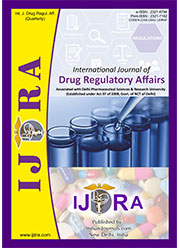Understanding OECD Guidelines for QSAR Models-A Software development and harmonization strategy
Abstract
Post GATT era has turned towards harmonization processes not only relating to trade, services, and taxation but also towards research processes to some extent. The current guideline especially helps in developing software that helps end users of software in overcoming ambiguities and come to a faster acceptance of the research by the authority. The objective of harmonization is to minimize time, expenditure, experimental animals, scrutiny and approval processes. The current article is to know how the Quantitative Structure Activity Relationship research is made uniform for the research community by developing a policy/guideline as an international standard setting.
Downloads
References
https://www.oecd-ilibrary.org/environment/guidance-document-on-the-validation-of-quantitative-structure-activity-relationship-q-sar-models_9789264085442-en
2. Breiman L, Friedman JH, Olshen RA, Stone CJ. Classification and Regression Trees, Wadsworth International Group, Belmont, CA, USA; 1984.
3. Hand D. Discrimination and Classification. New York: Wiley & Sons; 1981
4. Anzali S, Gasteiger J, Holzgrabe U, Polanski J, Sadowski J, Teckentrup A, Wagener M. The use of self organizing neural networks in drug design. Perspectives in Drug Discovery and Design. 1998;9–11:273–299.
5. Zupan J, Gasteiger J. Neural Networks for Chemistry and Drug Design. Weinheim, Germany: Wiley-VCH; 1999.
6. Diaconis P, Efron B. Computer Intensive Methods in Statistics. Scientific American. 1983;248:96-108.
7. Cramer RD, Bunce JD, Patterson DE, Frantk IK. Cross Validation, Bootstrapping and Partial Least Squares Compared with Multiple Regression in Conventional QSARs Studies. Quant. Struct-Act Relat. 1988;7:18-25.
8. Wehrens R, Putter H, Buydens LMC. Bootstrap: a Tutorial. Chemometrics and Intelligent Laboratory Systems. 2000;54:35-52.
9. Lindgren F, Hansem B, Karcher W, Sjostrom M, Eriksson L. Model Validation by Permutation Tests: Applications to Variable Selection. Journal of Chemometrics. 1996;10:421-532.
10. Todeschini R, Consonni V, Maiocchi A. The K Correlation Index: Theory Development and Its Applications in Chemometrics. Chemometrics and Intelligent Laboratory Systems. 1999;46:13-29.
11. Todeschini R, Consonni V, Mauri A, Pavan M. Detecting Bad Regression Models: Multicriteria Fitness Functions in Regression Analysis. Analytica Chimica Acta. 2004;515(1):199-208.
12. Jouan-Rimbaud D, Massart DL, de Noord OE. Random Correlation in Variable Selection for Multivariate Calibration with a Genetic Algorithm. Chemometrics and Intelligent Laboratory Systems. 1996;35:213-220.
13. Golbraikh A, Tropsha A. Beware of q2! Journal of Molecular Graphics and Modelling. 2002;20:269-276.
14. Gramatica P, Pilutti P, Papa E. Validated QSAR Prediction of OH Tropospheric Degradation of VOCs: Splitting into Training-Test Sets and Consensus Modeling. Journal of Chemical Information and Computer Sciences. 2004;44:1794-1802.
15. Gramatica P, Papa P. An Update of the BCF QSAR Model Based on Theoretical Molecular Descriptors. QSAR and Comb. Sci. 2005;24:953-960.
16. Pavan M, Netzeva TI, Worth AP. Validation of a QSAR Model for Acute Toxicity. SAR and QSAR in Environmental Research. 2006;17:147-171.
17. Zeeman M, Auer CM, Clements RG, Nabholz JV, Boethling RS. U.S. EPA Regulatory Perspectives on the Use of QSAR for New and Existing Chemical Evaluations. SAR and QSAR in Environmental Research. 1995;3:179-201.

This work is licensed under a Creative Commons Attribution-NonCommercial 4.0 International License.
The International Journal of Drug Regulatory affairs require a formal written transfer of copyright from the author(s) for each article published. We therefore ask you to complete and return this form, retaining a copy for your records. Your cooperation is essential and appreciated. Any delay will result in a delay in publication.
I/we have read and agree with the terms and conditions stated Page 2 of this agreement and I/we hereby confirm the transfer of all copyrights in and relating to the above-named manuscript, in all forms and media, now or hereafter known, to the International Journal of Drug Regulatory affairs, effective from the date stated below. I/we acknowledge that the IJDRA is relying on this agreement in publishing the above-named manuscript. However, this agreement will be null and void if the manuscript is not published in the IJDRA.
Download link for COPYRIGHT FORM







